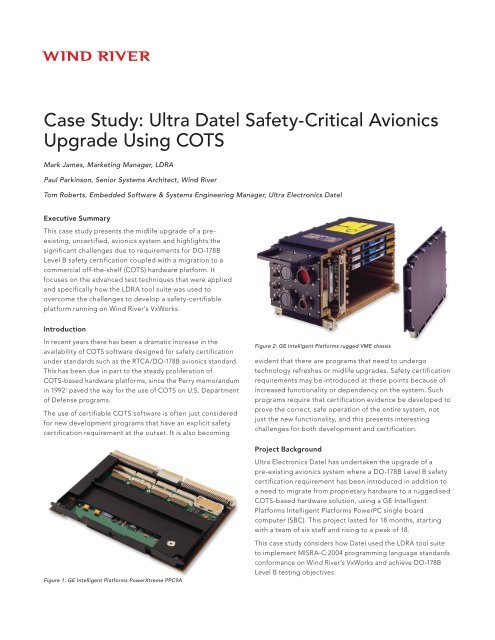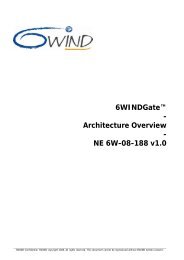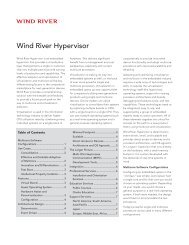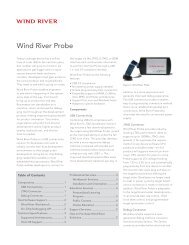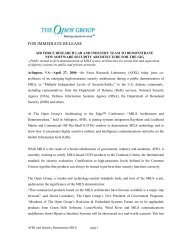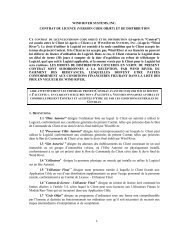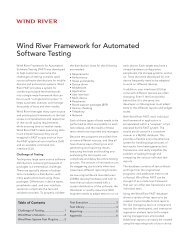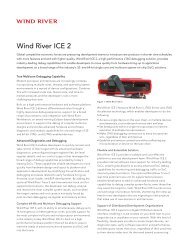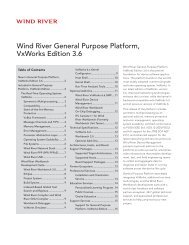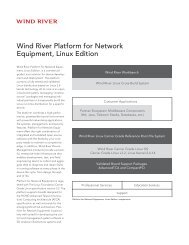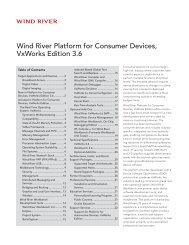Case Study: Ultra Datel Safety-Critical Avionics ... - Wind River
Case Study: Ultra Datel Safety-Critical Avionics ... - Wind River
Case Study: Ultra Datel Safety-Critical Avionics ... - Wind River
You also want an ePaper? Increase the reach of your titles
YUMPU automatically turns print PDFs into web optimized ePapers that Google loves.
<strong>Case</strong> <strong>Study</strong>: <strong>Ultra</strong> <strong>Datel</strong> <strong>Safety</strong>-<strong>Critical</strong> <strong>Avionics</strong><br />
Upgrade Using COTS<br />
Mark James, Marketing Manager, LDRA<br />
Paul Parkinson, Senior Systems Architect, <strong>Wind</strong> <strong>River</strong><br />
Tom Roberts, Embedded Software & Systems Engineering Manager, <strong>Ultra</strong> Electronics <strong>Datel</strong><br />
Executive Summary<br />
This case study presents the midlife upgrade of a preexisting,<br />
uncertified, avionics system and highlights the<br />
significant challenges due to requirements for DO-178B<br />
Level B safety certification coupled with a migration to a<br />
commercial off-the-shelf (COTS) hardware platform. It<br />
focuses on the advanced test techniques that were applied<br />
and specifically how the LDRA tool suite was used to<br />
overcome the challenges to develop a safety-certifiable<br />
platform running on <strong>Wind</strong> <strong>River</strong>’s VxWorks.<br />
Introduction<br />
In recent years there has been a dramatic increase in the<br />
availability of COTS software designed for safety certification<br />
under standards such as the RTCA/DO-178B avionics standard.<br />
This has been due in part to the steady proliferation of<br />
COTS-based hardware platforms, since the Perry memorandum<br />
in 1992 1 paved the way for the use of COTS on U.S. Department<br />
of Defense programs.<br />
The use of certifiable COTS software is often just considered<br />
for new development programs that have an explicit safety<br />
certification requirement at the outset. It is also becoming<br />
Figure 1: GE Intelligent Platforms PowerXtreme PPC9A<br />
Figure 2: GE Intelligent Platforms rugged VME chassis<br />
evident that there are programs that need to undergo<br />
technology refreshes or midlife upgrades. <strong>Safety</strong> certification<br />
requirements may be introduced at these points because of<br />
increased functionality or dependency on the system. Such<br />
programs require that certification evidence be developed to<br />
prove the correct, safe operation of the entire system, not<br />
just the new functionality, and this presents interesting<br />
challenges for both development and certification.<br />
Project Background<br />
<strong>Ultra</strong> Electronics <strong>Datel</strong> has undertaken the upgrade of a<br />
pre-existing avionics system where a DO-178B Level B safety<br />
certification requirement has been introduced in addition to<br />
a need to migrate from proprietary hardware to a ruggedised<br />
COTS-based hardware solution, using a GE Intelligent<br />
Platforms Intelligent Platforms PowerPC single board<br />
computer (SBC). This project lasted for 18 months, starting<br />
with a team of six staff and rising to a peak of 18.<br />
This case study considers how <strong>Datel</strong> used the LDRA tool suite<br />
to implement MISRA-C:2004 programming language standards<br />
conformance on <strong>Wind</strong> <strong>River</strong>’s VxWorks and achieve DO-178B<br />
Level B testing objectives.
GE Intelligent Platforms<br />
Development Challenges<br />
This project faced a number of development challenges<br />
because the pre-existing software and device drivers were<br />
not developed with safety certification in mind, and code<br />
needed to be re-engineered and modified to meet safety<br />
certification requirements.<br />
Challenge 1: Porting to the VxWorks DO-178B <strong>Safety</strong>-<br />
<strong>Critical</strong> Subset<br />
In practical terms, in order to achieve DO-178B Level B safety<br />
certification, a subset of the full VxWorks real-time operating<br />
system (RTOS) application programming interface (API) is<br />
used. This safety-critical subset excludes functionality that<br />
could compromise predictability and determinism (e.g.,<br />
SCSI). In order to determine the dependencies of the existing<br />
project code on nonsubset functionality, <strong>Datel</strong> performed<br />
static analysis of the source code.<br />
This approach also provides visibility of the impact of the<br />
changes to the code because if companies are not actively<br />
working toward the implementation and enforcement of<br />
coding standards or best practices a number of problems can<br />
arise. These can include inconsistency of coding styles and<br />
implementation, which can make source code peer review<br />
difficult and therefore adversely affect the ongoing<br />
maintainability of the code.<br />
Challenge 2: Reduction of High Cyclomatic Complexity<br />
The static analysis of the source code performed by the LDRA<br />
tool suite also revealed that some of the existing project<br />
code exhibited high cyclomatic complexity, which reflects a<br />
complex decision-making structure in terms of a directed<br />
graph. High cyclomatic complexity is undesirable for safety<br />
certification because the associated high number of paths<br />
through the code and complex conditions mean that it is<br />
complex and time consuming to perform functional and<br />
code-coverage testing.<br />
As such, the development team used the results of the static<br />
analysis at the individual function level to determine which<br />
functions should be considered for modification or<br />
reimplementation in order to reduce cyclomatic complexity<br />
and better facilitate testing and safety certification. In some<br />
cases the risk of change had to be carefully weighed against<br />
the risk of failure.<br />
In addition to verifying that the software is properly<br />
structured, this static analysis approach may be used to<br />
ensure that programming standards are uniformly enforced<br />
and the obvious benefits are recognized by many regulatory<br />
authorities that approve the use of such techniques for the<br />
development of safety-critical software.<br />
2 | <strong>Case</strong> <strong>Study</strong>: <strong>Ultra</strong> <strong>Datel</strong> <strong>Safety</strong>-<strong>Critical</strong> <strong>Avionics</strong> Upgrade Using COTS<br />
Challenge 3: Programming Language Subset Compliance<br />
The project selected a subset of the C programming<br />
language MISRA-C:2004 2 for the upgrade in order to reduce<br />
the risk of coding errors, facilitate ease of maintenance, and<br />
enable future portability. MISRA-C (Motor Industry Software<br />
Reliability Association) was originally developed through the<br />
collaboration between automotive manufacturers,<br />
engineering consultancies, and tools developers to promote<br />
best practice and commonality in the development of<br />
safety-related automotive electronics and other embedded<br />
systems. However, since its publication, it has quickly become<br />
regarded as a “best practice” for the development of C in<br />
embedded and safety-related systems and has been widely<br />
adopted in the aerospace, defense, and industrial sectors.<br />
The MISRA-C language subset has been designed to<br />
promote portability and ensure that there is no reliance<br />
placed on compiler-specific or platform-specific constructs<br />
that could lead to unexpected or unpredictable results. It<br />
also restricts the use of certain C language constructs that<br />
are known to be a common source of errors and reduces<br />
program complexity that helps improve software<br />
maintainability. When applied to DO-178B software<br />
development, this can help to make the software more<br />
suitable for testing, which can provide tangible benefits in<br />
terms of reducing the effort required to perform functional<br />
testing and code-coverage testing as part of the safety<br />
certification process.<br />
The project development team, however, was faced with a<br />
further challenge because the original code had not been<br />
written to conform to the MISRA-C:2004 subset or its<br />
predecessor. Therefore, many of the functions violated<br />
multiple MISRA-C rules. The team was faced with the<br />
decision of whether to change the code to comply with<br />
MISRA-C rules and risk failure through inadvertently<br />
changing the behavior of the code.<br />
Difficult decisions had to be made to justify which rules<br />
should be adhered to from the MISRA-C:2004 standard and<br />
which rules could be relaxed. For example, some functions<br />
contained code with extensive and complex control decision<br />
logic and multiple return statements. To comply with strict<br />
MISRA-C:2004 enforcement it would be expected that such<br />
code should be refactored. However, in so doing there is<br />
always the risk that the control flow could be altered, and<br />
<strong>Datel</strong> was therefore left to decide whether much would<br />
actually be gained under such circumstances. Once these<br />
choices were made, <strong>Datel</strong> was able to create a custom profile<br />
within the LDRA tool suite to reflect its choice of MISRA-C<br />
rules.
Challenge 4: Code Coverage Challenges to Meet DO-178B<br />
Level B Objectives<br />
DO-178B Level B safety certification requires that block,<br />
statement, and decision-level code coverage be undertaken<br />
on the software. However, the existing software comprised<br />
80,000 source lines of code (SLOC), which had not been<br />
written with code-coverage testing in mind, making it difficult<br />
to manually determine all of the test cases that would be<br />
required.<br />
To overcome this issue, the <strong>Datel</strong> development team used<br />
LDRA TBeXtreme for source code analysis and automated<br />
test case generation and dramatically reduced the time<br />
required for unit and code coverage testing. In addition, the<br />
development team members were able to perform unit<br />
testing of C packages in parallel and integrate the results,<br />
reducing the overall testing time.<br />
<strong>Datel</strong> also utilized the extensive command-line automation<br />
facilities of the LDRA tool suite to perform nightly regression<br />
test runs to ensure that code changes did not introduce<br />
errant behavior. This approach was used in conjunction with<br />
real target hardware for certification testing rather than a<br />
simulated environment that might exhibit different behavior<br />
to the actual hardware.<br />
Finally, a comparison of the baseline and modified code was<br />
required to verify functionality. The LDRA tool suite was<br />
again used to automate this process and highlight source<br />
code changes between baseline and modified versions and<br />
report on untested source code that was affecting the overall<br />
code coverage analysis metrics.<br />
Conclusion<br />
<strong>Datel</strong> made a number of significant achievements in this<br />
safety-critical avionics upgrade project through use of the<br />
LDRA tool suite and <strong>Wind</strong> <strong>River</strong>’s safety-critical VxWorks<br />
operating system.<br />
It was able to reduce risk associated with modifications to the<br />
project source code through the information provided by the<br />
source code analysis and MISRA-C rule checking. It was also<br />
able to reduce testing time through automated test case<br />
generation and parallel working, resulting in a starting<br />
baseline of approximately 90 percent code coverage. The<br />
support for automated regression testing also enabled them<br />
to introduce changes and verify their impact quickly and with<br />
traceability.<br />
The outcome of the project was the creation of a DO-178B<br />
Level B certified safety-critical software system, which was<br />
delivered to the customer, who in turn will perform system<br />
integration testing with its application, also making use of<br />
the LDRA tool suite.<br />
About <strong>Ultra</strong> <strong>Datel</strong><br />
<strong>Ultra</strong> Electronics <strong>Datel</strong> is part of the <strong>Ultra</strong> Electronics Group<br />
and has been in business for more than 25 years. <strong>Datel</strong><br />
specializes in mission- and safety-critical software development<br />
to a variety of civil standards, including RTCA/DO-178B<br />
and UK MOD Defense Standard 00-55/00-56. <strong>Datel</strong> also<br />
provides services in systems integration, consultancy, and<br />
secure information management solutions.<br />
About LDRA<br />
For more than 30 years LDRA has developed and driven the<br />
market for software used for the automation of code analysis<br />
and software testing of safety-critical applications. The<br />
LDRA tool suite is widely used in the aerospace and defense<br />
technology, nuclear energy, and automotive industries.<br />
Through the use of the LDRA tool suite, companies ensure<br />
that their systems are built in accordance with prescribed<br />
standards and are durable and reliable in use. The LDRA tool<br />
suite is available for a variety of programming languages and<br />
supports a wide range of host and target platforms. LDRA is<br />
represented worldwide, with its head office in the UK and<br />
subsidiaries in the United States, supported by an extensive<br />
distributor network. For more information on the LDRA tool<br />
suite, visit http://www.ldra.com.<br />
About <strong>Wind</strong> <strong>River</strong><br />
<strong>Wind</strong> <strong>River</strong>, a wholly owned subsidiary of Intel Corporation,<br />
is the global leader in embedded technologies. <strong>Wind</strong> <strong>River</strong><br />
enables companies to develop, run, and manage device soft-<br />
ware faster, better, at lower cost, and more reliably. <strong>Wind</strong> <strong>River</strong><br />
platforms are pre-integrated, fully standardized, enterprise-wide<br />
development solutions. They reduce effort, cost, and risk and<br />
optimize quality and reliability at all phases of the device<br />
software development process, from concept to deployed<br />
product. Founded in 1981, <strong>Wind</strong> <strong>River</strong> is headquartered in<br />
Alameda, California, with operations worldwide. To learn more,<br />
visit <strong>Wind</strong> <strong>River</strong> at www.windriver.com.<br />
Notes<br />
1. W. Perry, U.S. Secretary of State for Defense,<br />
“Specifications & Standards – A New Way of Doing<br />
Business,” U.S. DOD Memorandum (1994).<br />
2. “Guidelines for the Use of the C Language in <strong>Critical</strong><br />
Systems,” MISRA-C:2004, Motor Industry Software<br />
Reliability Association, http://www.misra.org.uk.<br />
<strong>Wind</strong> <strong>River</strong> is the global leader in Device Software Optimization (DSO). We enable companies to develop,<br />
run, and manage device software faster, better, at lower cost, and more reliably. www.windriver.com<br />
© 2009 <strong>Wind</strong> <strong>River</strong> Systems, Inc. The <strong>Wind</strong> <strong>River</strong> logo is a trademark of <strong>Wind</strong> <strong>River</strong> Systems, Inc., and <strong>Wind</strong> <strong>River</strong> and VxWorks are registered trademarks of <strong>Wind</strong> <strong>River</strong> Systems, Inc.<br />
Other marks used herein are the property of their respective owners. For more information, see www.windriver.com/company/terms/trademark.html. Rev. 12/2009


